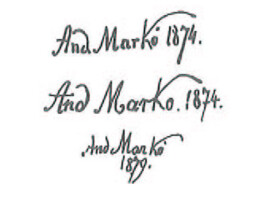
Markò Andrea *
MARKÒ ANDREA
Vienna 1826 – Firenze 1895
Allievo del padre Carlo, con il quale era giunto in Italia nel 1832, cominciò a esporre nella seconda metà degli anni ’40 alla Promotrice fiorentina paesaggi e scene campestri di gusto nordico, di cui indicava sempre con diligenza i soggetti, quasi a ribadire la loro attinenza col dato reale. Dal 1854 col fratello Carlo e altri pittori paesisti, per lo più allievi del padre, si recò a dipingere dal vero nella campagna senese, dando vita alla cosiddetta Scuola di Staggia. Dalla fine degli anni ’50 subentrò al padre nella scuola di pittura di paese che quest’ultimo aveva avviato a Firenze e la diresse all’insegna della massima libertà di esecuzione. Nel 1861 partecipò alla I Esposizione Italiana con Carbonai (Firenze, Galleria d’Arte Moderna di Palazzo Pitti), esempio tipico della sua pittura di grande finitezza e di luminosità cristallina. Dopo un decennio di intensa attività anche espositiva iniziò a trascurare le mostre fiorentine e riprese a esporvi solo nel 1879 (1881, Torre del Lago). Negli anni tardi tornò a proporre soggetti campestri di grandi dimensioni, condotti con una definizione di gusto nordico. Il figlio Enrico (1855-1921) fu anch’egli paesaggista e presentò le sue opere fra il 1872 e il 1880 alle promotrici di Genova e di Firenze (1875, La torre del Maglio, Firenze, Museo Topografico).
